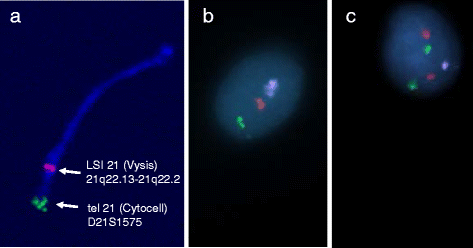Disomy 21 in spermatozoa and the paternal origin of trisomy 21 Down syndrome
- PMID: 26300975
- PMCID: PMC4545544
- DOI: 10.1186/s13039-015-0155-2
Disomy 21 in spermatozoa and the paternal origin of trisomy 21 Down syndrome
Abstract
Background: Trisomy 21 Down syndrome is the most common genetic cause for congenital malformations and intellectual disability. It is well known that in the outstanding majority of cases the extra chromosome 21 originates from the mother but only in less than 10 % from the father. The mechanism underlying this striking difference in parental origin of Trisomy 21 Down syndrome is still unknown. However, it seems likely that the main reason is a much higher stringency in the elimination of any trisomy 21 cells during fetal testicular than ovarian development. We have here focussed attention on the paternal gametic output, i.e. the incidence of disomy 21 in spermatozoa.
Results: We have used fluorescence in situ hybridisation (FISH) to determine the copy number of chromosome 21 in spermatozoa from 11 men with normal spermiograms. Due to the well-known risk of false positive and false negative signals using a single FISH probe, we have applied two chromosome 21q probes, and we have added a chromosome 18-specific probe to allow differentiation between disomy 21 and diploidy. Analysing a total number of 2000 spermatozoa per case, we documented an average incidence of disomy 21 at 0.13 %, with a range of 0.00-0.25 % and a SD of 0.08. There was no indication of diploidy in this cohort of 22,000 sperm.
Conclusion: Numerous previous studies on the incidence of disomy 21 in sperm have been published, using FISH. As far as we are aware, none of these have applied more than a single chromosome 21-specific probe. Accepting our mean of 0.13 % of disomy 21, and providing there is no selective fertilisation capability of disomy 21 sperm in relation to the normal, we conclude that around 1 in 800 conceptions is expected to be trisomic for chromosome 21 of paternal origin. Bearing in mind that the maternal origin likely is at least 10 times more common, we tentatively propose that around 1 in 80 oocytes in the maternal ovarian reserve may be disomy 21. One reason for this discrepancy may be a more stringent selection against aberrant chromosome numbers during spermatogenesis than oogenesis. Further work is required to determine the relevant stages of spermatogenesis at which such a selection may take place.
Keywords: Chromosome copy number; Disomy 21; Down syndrome; Fluorescence in situ hybridisation (FISH); Paternal origin; Spermatozoa; Trisomy 21.
Figures

Similar articles
-
On the paternal origin of trisomy 21 Down syndrome.Mol Cytogenet. 2010 Feb 23;3:4. doi: 10.1186/1755-8166-3-4. Mol Cytogenet. 2010. PMID: 20178584 Free PMC article.
-
Non-disjunction in human sperm: results of fluorescence in situ hybridization studies using two and three probes.Hum Mol Genet. 1993 Nov;2(11):1929-36. doi: 10.1093/hmg/2.11.1929. Hum Mol Genet. 1993. PMID: 8281157
-
On the origin of trisomy 21 Down syndrome.Mol Cytogenet. 2008 Sep 18;1:21. doi: 10.1186/1755-8166-1-21. Mol Cytogenet. 2008. PMID: 18801168 Free PMC article.
-
Etiology of nondisjunction in humans.Environ Mol Mutagen. 1995;25 Suppl 26:38-47. doi: 10.1002/em.2850250608. Environ Mol Mutagen. 1995. PMID: 7789361 Review.
-
Aneuploidy in human spermatozoa.Cytogenet Genome Res. 2011;133(2-4):91-9. doi: 10.1159/000323795. Epub 2011 Jan 29. Cytogenet Genome Res. 2011. PMID: 21282942 Review.
Cited by
-
Drug-Targeted Genomes: Mutability of Ion Channels and GPCRs.Biomedicines. 2022 Mar 3;10(3):594. doi: 10.3390/biomedicines10030594. Biomedicines. 2022. PMID: 35327396 Free PMC article.
-
Trisomy 21 and Assisted Reproductive Technologies: A review.JBRA Assist Reprod. 2022 Jan 17;26(1):129-141. doi: 10.5935/1518-0557.20210047. JBRA Assist Reprod. 2022. PMID: 34542250 Free PMC article. Review.
References
-
- Morris JK, Alberman E, Mutton D, Jacobs P. Cytogenetic and epidemiological findings in Down syndrome: England and Wales 1989-2009. Am J Med Genet A. 2012;158a(5):1151-7. doi:10.1002/ajmg.a.35248. - PubMed
LinkOut - more resources
Full Text Sources
Other Literature Sources
Research Materials

